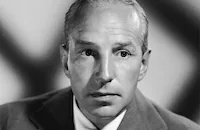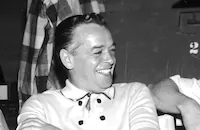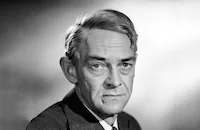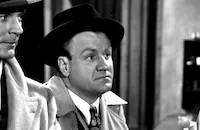The Street with No Name

Brief Synopsis
Cast & Crew
William Keighley
Mark Stevens
Richard Widmark
Lloyd Nolan
Barbara Lawrence
Ed Begley
Film Details
Technical Specs

Synopsis
A crime wave, including a holdup and killing at a nightclub and a bank robbery in which a guard is killed, has hit Center City. A squad of FBI agents headed by inspector George A. Briggs meets with local FBI field officer Richard Atkins, police chief Bernard Harmatz and commissioner Ralph Demory. After Briggs interrogates suspect Robert Danker, who claims he was not involved in either killing and that he has been framed, various tests are run at the FBI laboratory in Washington that exonorate Danker. Later, Danker, who has been bailed out by "John Smith," is found stabbed to death. At the FBI Academy in Quantico, Virginia, Briggs briefs agent Gene Cordell, who is going undercover in Center City to try to infiltrate the gang Briggs thinks is responsible for all three killings. Cordell takes a bus into Center City and takes a room at the same skid row hotel in which Danker had been living. Fellow agent Cy Gordon is in a similar hotel across the street from him. Using the name George Manly, Cordell makes himself known in the area by going to the local gym and picking a fight with one of the boxers training there. He is spotted by owner Alec Stiles, who offers him cash if he can last against the boxer. He does so and Alec pays him off. Later, in a nearby amusement arcade, Cordell tells Gordon that while he was at the gym, his Social Security card was stolen. As they talk, two policemen approach and arrest Cordell for a break-in at a jewelry store, where his card has been found. The FBI has provided a false record for Cordell, and he is bailed out by John Smith, who turns out to be Stiles. Through the police department, Stiles has acquired a copy of Cordell's phony FBI record and is impressed enough to invite him to join his organization. Later, Cordell meets with Briggs on board a ferry, and his report convinces Briggs that the Stiles gang are their culprits. After Stiles and his henchmen plan a robbery of a local mansion, Stiles has a violent argument with his girl friend Judy. Cordell alerts Gordon about the robbery and the FBI and police prepare an ambush, but Stiles' informant within the police department tips him off and he cancels the job. Cordell returns to gang headquarters and fires a shot from Stiles' revolver in order to recover the bullet for testing. However, Stiles discovers that his gun has been fired and goes to see his informant, Commissioner Demory, and asks him to have his gun checked for fingerprints. Demory later advises Stiles that his gang has been infiltrated by Cordell. Shivvy and Matty, two of Stiles' henchmen, take Cordell to see Stiles and Gordon follows them in a taxi. Briggs, who has been observing Stiles and can link him to Demory, then receives a report from Washington that the barrel markings on the bullet fired from Stiles' gun are identical with those on the bullets used in the previous kilings. After Gordon tracks Shivvy, Matty and Cordell to a factory, he tells the taxi driver to get word to Briggs as to where he is. Inside the plant, Shivvy discovers and then stabs Gordon. Cordell does not realize he has been found out until Stiles announces he is going to frame him and have Demory's officers "accidentally" kill him. However, the plan backfires when Briggs and Chief Harmatz arrive with backup and chase Stiles through the factory. Cordell corners Stiles and kills him, and as Briggs arrests Demory, agent Gordon recovers.

Director

William Keighley
Cast

Mark Stevens

Richard Widmark

Lloyd Nolan

Barbara Lawrence

Ed Begley

Donald Buka

Joseph Pevney

John Mcintire
Walter Greaza
Howard Smith
Bill Mauch
Sam Edwards
Don Kohler
Vincent Donahue

Phillip Pine
Buddy Wright
Larry Anzalone
Robert Karnes
Robert Patten
Joan Blair
Kitty Mchugh
Jack Herrick
Joe Haworth

Randy Stuart

Marion Marshall
Mike Kilian
Robert B. Williams
Edmund Cobb
Johnny Kern
Philip Van Zandt
Al Thompson
George Leonard
Billy Wayne
Don Jessee
Joe Mcgurk
Wally Scott
Wally Rose
Charles Tannen
Kid Wagner
Fred Graham
Sammy Shack
Michael Sheridan

Lyle Latell
Roger Mcgee
Crew
Gene Bryant
David Buttolph
Frank Cory Jr.
Samuel G. Engel
Samuel G. Engel
Kathleen Fagan
Freddie Fisher
W. D. Flick
Atillio Gabani
Chester Gore
Earle H. Hagen
Roger Heman
John Indrisano
Harry Kleiner
Charles Lemaire
Thomas Little
Joe Macdonald
P. A. Marquardt
Charles Maxwell
Kay Nelson
Alfred Newman
Lionel Newman
Ben Nye
Jack Perry
Edward Powell
William Reynolds
Frank Serjack
Fred Sersen
Urban Thielmann
Tommy Tuttle
Anthony Ugrin
Henry Weinberger
Lyle Wheeler
Darryl F. Zanuck

Videos
Movie Clip



Hosted Intro
Film Details
Technical Specs

Articles
The Street with No Name
The Street With No Name gets off to an unpromising start but becomes a gripping thriller. The film begins with the FBI's logo (in much the same way as the 1960s and 1970s television series, The FBI did) and a written statement from FBI chief J. Edgar Hoover warning that "organized gangsterism is returning." It continues with staccato narration, spending a bit too much time on documentary-style footage of FBI employees at work. Then it introduces Mark Stevens, as a stalwart agent who goes undercover (using the tongue-in-cheek pseudonym George Manly) as a boxer in order to infiltrate the crime ring. But once the movie gets down to business and Widmark shows up about twenty minutes in--a great entrance, sharply dressed, surrounded by thugs, and casually eating an apple--the film comes to life. From then on, it's Widmark's film, and he makes the most of his character's idiosyncrasies, such as using an inhaler and being afraid of drafts. And, as in Kiss of Death, he has a terrific death scene.
With The Street With No Name, the public and the critics sat up and took notice of Widmark. "No actor yet has managed to move in the furtive, feline way that this fellow does, and few have shown us such cruelty in the face. His timing and tension are perfect and the timber of his voice is that of filthy water going down a sewer," raved Bosley Crowther of the New York Times. Crowther's review had high praise for the entire production, calling it "A sizzling crime film....William Keighley has directed it swiftly and with sharp emphasis and, as a consequence, it packs the old punch."
The Street With No Name did well at the box office, and Widmark played another villain in his next film, Yellow Sky (1948). The poster for that film featured stars Gregory Peck and Ann Baxter in an embrace, and Widmark sneering. Over the years, Widmark was able to demonstrate his versatility, playing heroic roles and complex characters as well as villains. But his most memorable performances arguably remained those terrifying sociopaths he played at the beginning of his film career.
Director: William Keighley
Producer: Samuel G. Engel
Screenplay: Harry Kleiner
Cinematography: Joe MacDonald
Editor: William Reynolds
Art Direction: Lyle Wheeler
Music: Lionel Newman
Principal Cast: Mark Stevens (Gene Cordell/George Manly), Richard Widmark (Alec Stiles), Lloyd Nolan (Inspector George A. Briggs), Barbara Lawrence (Judy Stiles), Ed Begley (Police Chief Bernard Harmatz), Donald Buka (Shivvy), Joseph Pevney (Matty), John McIntire (Cy Gordon)
91 minutes
by Margarita Landazuri

The Street with No Name
Quotes
Trivia
Notes
This film's working titles were The FBI Story, Manhunt and The Greatest Crime. The opening credits include the following written foreword: "The motion picture you are about to see was adapted from the files of the Federal Bureau of Investigation. Wherever possible, it was photographed in the original locale and played by the actual FBI personnel involved." This is followed by a written message from J. Edgar Hoover: "The street on which crime flourishes is the street extending across America. It is the street with no name. Organized gangsterism is once again returning. If permitted to go unchecked three out of every four Americans will eventually become its victims. Wherever law and order break down there you will find public indifference. An alert and vigilant America will make for a secure America."
According to documents in the Twentieth Century-Fox Records of the Legal Department and the Twentieth Century-Fox Produced Scripts Collection at the UCLA Arts-Special Collections Library, The Street with No Name originally was to be made by Louis de Rochemont as a sequel to his 1945 documentary-like film The House on 92nd Street (see entry above) in which Lloyd Nolan first portrayed "Inspector Briggs." Throughout the last half of 1946 and into the spring of 1947, writer Eugene Ling produced several outlines and a first draft screenplay, based on research he had done at FBI headquarters in Washington. Harry Kleiner's screenplay was based on Ling's outlines, but the extent of Ling's contribution to the released film has not been determined.
Various locations in and around Los Angeles were used in the picture to depict "Center City," including the downtown Los Angeles Orner Gymnasium, the Royal and Gilbert Hotels, the American Bus Co. Depot and an amusement arcade on Main Street, as well as the FBI's Los Angeles office on Spring Street. Additional locations included the Lincoln Heights Jail, a bond company opposite the jail, the exteriors of a house on Glenbarr Street in Cheviot Hills and an apartment building on So. Bixel Street, the Meadowbrook Café in Culver City, the Lido Café on So. Harbor Blvd, the San Pedro Municipal Ferry Building and a bank exterior in Inglewood. The Holly Sugar factory in Santa Ana was used as the factory in the film's climax. Sequences were also filmed at the FBI Headquarters in Washington, D.C. and at the FBI Academy in Quantico, VA. A studio press release in the AMPAS Library states that out of a sixty-five-day shooting schedule, only three days were spent shooting at the studio.
Joan Chandler was cast in the role of Mark Stevens' fiancée but that character does not appear in the completed film. Some music written for The House on 92nd Street was reused in this film, according to studio records. A radio adaptation of the film featuring Richard Widmark, Lloyd Nolan and Mark Stevens was broadcast on Lux Radio Theatre on January 31, 1949 and again on December 12, 1949 with Mark Stevens and Stephen McNally. On November 17, 1949, Screen Guild Players broadcast another radio adaptation featuring Richard Widmark and Mark Stevens. In 1955, Twentieth Century-Fox remade the story as House of Bamboo, which was directed by Samuel Fuller and starred Robert Stack, Robert Ryan and Shirley Yamaguchi.















